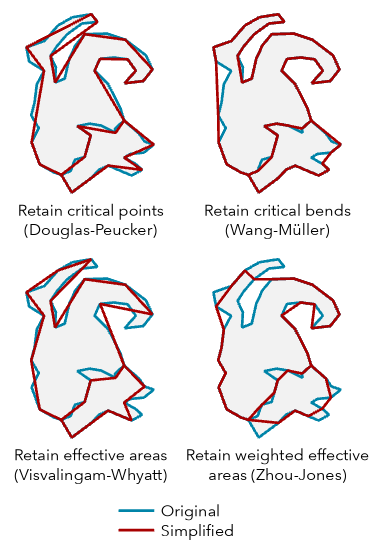| Label | Explanation | Data Type |
Input Features | The input polygon features that will be simplified. | Feature Layer |
Output Feature Class | The simplified output polygon feature class. It will contain all the fields from the input feature class. The output polygon feature class is topologically correct. The tool does not introduce topology errors, but topological errors in the input data will be flagged in the output polygon feature class. The output feature class will include the InPoly_FID and SimPgnFlag fields to contain the input feature IDs and the input topological errors or discrepancies, respectively. The SimPgnFlag attribute values are as follows:
| Feature Class |
Simplification Algorithm | Specifies the polygon simplification algorithm that will be used.
| String |
Simplification Tolerance | The degree of simplification that will be used. You can choose a preferred unit; otherwise, the units of the input will be used. The MinSimpTol and MaxSimpTol fields will be added to the output to store the tolerance that was used when processing occurred.
| Linear Unit |
Minimum Area (Optional) | The minimum area for a polygon to be retained. The default value is zero, that is, to keep all polygons. You can choose a preferred unit for the specified value; otherwise, the units of the input will be used. | Areal Unit |
Handling Topological Errors (Optional) | Specifies how topological errors will be handled. Topological errors may be introduced in the simplification process and can include lines crossing or overlapping lines.
| String |
Keep collapsed points (Optional) | Specifies whether an output point feature class will be created to store the centers of polygons that are removed because they are smaller than the Minimum Area parameter value. The point output is derived; it will use the same name and location as the Output Feature Class parameter value but with a _Pnt suffix.
| Boolean |
Input Barrier Layers
(Optional) | The inputs containing features to act as barriers for simplification. Resulting simplified polygons will not touch or cross barrier features. For example, when simplifying forested areas, the resulting simplified forest polygons will not cross road features defined as barriers. | Feature Layer |
Derived Output
| Label | Explanation | Data Type |
| Polygons Collapsed To Zero Area | When the Keep collapsed points parameter is checked, an output point feature class is created to store points that represent polygons that are removed because they are smaller than the minimum area. | Feature Class |
